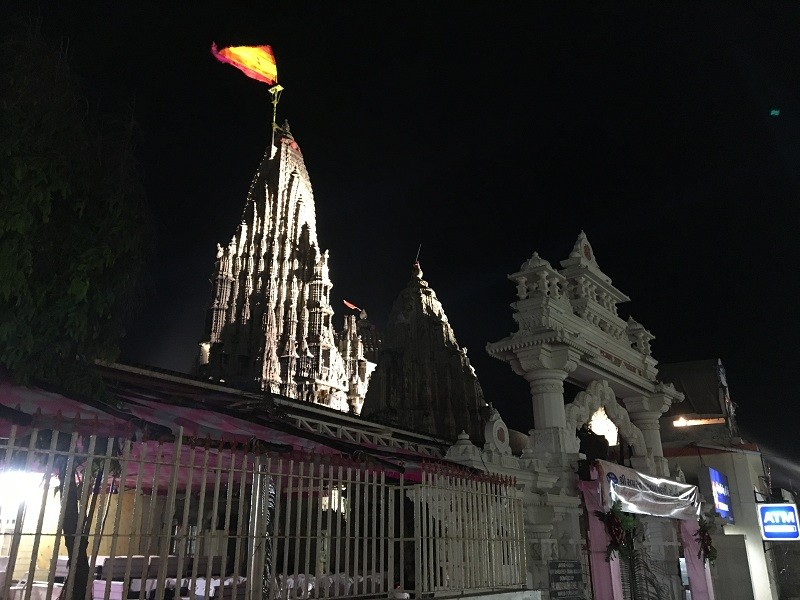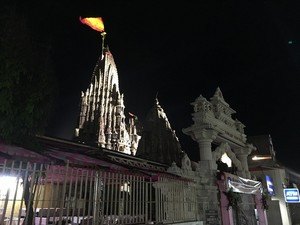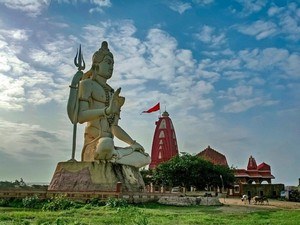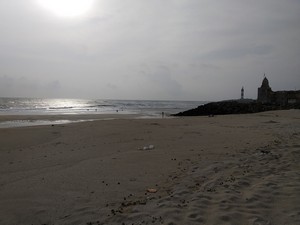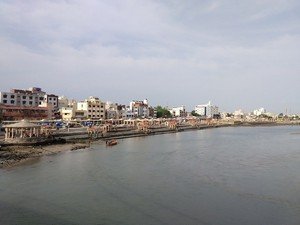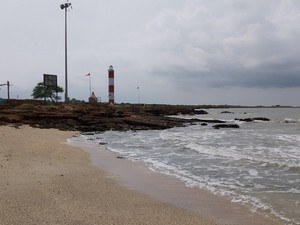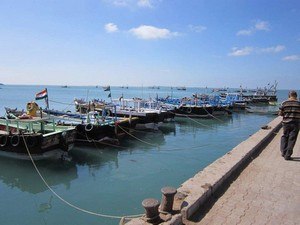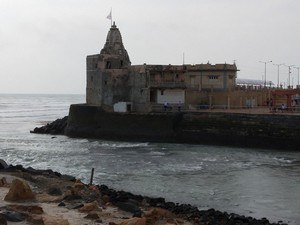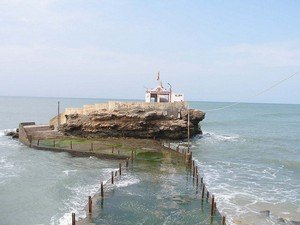Dwarkadhish Temple, Dwarka - Timings, Festivals, History, Darshan, Pooja Timings
Photo Credit: Flickr
 #1 of 16 Places to Visit in Dwarka
#1 of 16 Places to Visit in Dwarka
 Distance (From Dwarka Railway Station): 3 Kms
Distance (From Dwarka Railway Station): 3 Kms
 Trip Duration (Including Travel): 2-3 Hours
Trip Duration (Including Travel): 2-3 Hours
 Place Location: On The Banks Of Gomti River
Place Location: On The Banks Of Gomti River
 Transportation Options: Cab / Auto
Transportation Options: Cab / Auto
 Travel Tips: None
Travel Tips: None
About Dwarkadhish Temple
At a distance of 3 Km from Dwarka Railway Station, Dwarkadhish Temple is an ancient Hindu temple situated in the holy town of Dwarka, Gujarat. Situated on the banks of the Gomti River, Dwarkadhish Temple or Dwarkadheesh Temple is dedicated to Lord Krishna, who is worshiped here as Dwarkadhish or 'King of Dwarka'. Also known as Jagat Mandir or Trilok Sunder Temple, it is a part of the famed Char Dham, the four sacred temples dedicated to Lord Vishnu while the other three are Rameswaram, Badrinath, and Puri. Since it is a Pushtimarg temple, it follows the guidelines and rituals created by Vallabhacharya and Vitheleshnath. It is one of the revered temples in Gujarat, and among the must include places in Dwarka tour packages.
History of Dwarkadhish Temple
The Dwarkadhish Temple is a highly esteemed sanctuary dedicated to Lord Krishna, believed to have been initially constructed by his great-grandson Vajranabh over 2,500 years ago on the site of Lord Krishna's palace. Throughout its history, the temple has experienced numerous renovations and reconstructions. The original edifice was destroyed by Mahmud Begada during the 15th-16th century and was subsequently rebuilt and enhanced in the 16th century. The present idol of Dwarkadhish was installed by Aniruddhasrama Sankaracharya in 1559.
Mythology of Dwarkadhish Temple
The Dwarkadhish Temple, located in Gujarat, is associated with the narrative of Lord Krishna. As per the Mahabharata, Krishna founded the city of Dwarka following his victory over his uncle Kansa in Mathura. In retaliation for Kansa's demise, Jarasandha, Kansa's father-in-law, besieged Krishna's realm 17 times. To prevent further conflicts, Lord Krishna relocated his capital from Mathura to Dwarka, a city specifically designed by Vishwakarma, the Hindu deity of architecture, on a land area of 12 yojanas (96 sq. km) that was sanctified by the sea god, all accomplished in a mere two days. The city was referred to as 'Suvarna Dwarka' due to its embellishment with gold, emeralds, and precious stones used in the construction of the residences within Lord Krishna's 'Suvarna Dwarka'. It is said that Lord Krishna's original abode was at Bet Dwarka, from where he governed the entire Dwarka kingdom. Additionally, legend holds that after Lord Krishna left his physical form, the city submerged beneath the sea, with Samudradeva reclaiming what he had once bestowed. The Dwarkadhish Temple is thought to have been established by Vajranabha, Lord Krishna's great-grandson, as a tribute to the revered deity.
Architecture of Dwarkadhish Temple
Built out of soft limestone, Dwarkadhish Temple reflects the Chalukyan style of architecture. The five-storied main shrine is supported by 72 pillars and is a sight to behold. The temple consists of a sanctum, vestibule, and a rectangular hall with porches on three sides. It has an exquisitely carved 42 m high shikhara with a huge flag made from 52 yards of cloth. There are two main entrances to the temple. The main entrance (north entrance) is called Moksha Dwar, and the south entrance is called Swarga Dwar. Outside Swarga Dwar are 56 steps that lead to the Gomati River. The devotees are expected to take a dip in the Gomti River before proceeding into the temple through the Swarga Dwar.
The exterior is adorned with intricately carved sculptures and motifs from Hindu mythology that depicts the scenes of Krishna's life while the interior is quite simple and peaceful. The sanctum sanctorum of the temple houses the black magnificent idol of Lord Krishna as the resplendent king with four arms holding Sudarshana Chakra, Panchajanya or conch, lotus flower, and gada. This image of Lord Krishna is named Trivikrama and is the eighth avatar of Lord Vishnu. There are also other shrines within the temple that are devoted to Subhadra, Balarama and Revathi, Vasudeva, Rukmini, and many others. There is also a seat that belonged to Adi Shankaracharya here.
Among the top Dwarka places to visit, the temple of Dwarkadhish is famous for its flag worship. The flag or Dhwaja is considered to be of supreme importance in the temple and is changed four times a day. The flag, stitched out of 52 yards of cloth, is a spiritual icon and bears the images of the sun and the moon which is believed to indicate that Krishna would be there till the Sun and moon exist on earth.
Festivals of Dwarkadhish Temple
Janmashtami is the most important festival celebrated at Dwarkadhish Temple held in August/September every year during which thousands of devotees throng to this temple in order to witness the grand festivities. During this festival, the lord is decked up in his most royal avatar with abundant jewels such as gold, diamond, and topaz. Holi, Rukmini Vivah, Basant Panchami, Ram Navami, Akshay Tritiya, Deepawali, and Sharad Purnima are the other popular festivals celebrated in this temple.
Dwarkadhish Temple Dress Code & Other Restrictions
When planning a visit to the Dwarkadhish Temple in Dwarka, it is advisable to wear modest attire that covers the upper arms and legs as a mark of respect. Men should consider donning a dhoti or pajama with an upper garment, or alternatively, formal trousers and shirts. Women may choose to wear a saree, half saree, or chudidhars. It is recommended to avoid modern clothing such as mini-skirts, jeans, shorts, and sleeveless tops while on the temple premises.
Non-Hindus are generally allowed to visit the Dwarkadhish Temple in Dwarka. The temple welcomes visitors from all religious backgrounds who seek to appreciate its architectural splendor, historical importance, and cultural value.
Dwarkadhish Temple Timings
Monday: 6:30 AM - 1 PM & 5 PM - 9:30 PM
Tuesday: 6:30 AM - 1 PM & 5 PM - 9:30 PM
Wednesday: 6:30 AM - 1 PM & 5 PM - 9:30 PM
Thursday: 6:30 AM - 1 PM & 5 PM - 9:30 PM
Friday: 6:30 AM - 1 PM & 5 PM - 9:30 PM
Saturday: 6:30 AM - 1 PM & 5 PM - 9:30 PM
Sunday: 6:30 AM - 1 PM & 5 PM - 9:30 PM
Dwarkadhish Temple Entry Fee
General Entry is Free
Special Darshan available for Rs. 200
VIP Darshan available for Rs. 500
Best Time to Visit Dwarkadhish Temple
The ideal time to visit Dwarka Temple is from October to March when the town experiences cold winters suitable for temple exploration. If you specifically want to participate in the grand festivities of the Janmashtami festival, visiting the temple during August and September will be eventful. The entire town comes alive during this time and thousands of people visit the temple and participate in the festivities. Conversely, the summer months from April to June can be quite severe due to elevated temperatures, while the monsoon season from July to September is characterized by heavy rainfall and strong winds, which may not be conducive for travel.
How to Reach Dwarkadhish Temple
Jamnagar Airport is the nearest airport which is about 126 Km from Dwarka and has direct flights from Mumbai. Dwarka Railway Station is well connected by trains with Okha, Tuticorin, Guwahati, Gorakhpur, Rajkot, Ahmedabad, Somnath, Allahabad, Varanasi, Puri, Rameswaram, Jaipur, Bhavnagar, Kochi, Howrah, Nathdwara, and Viramgam. Dwarka has well road connectivity with Rajkot, Ahmedabad, Amreli, Porbandar, Somnath, Gandhidham, Bhuj, Gandhinagar, Baroda, Bhavnagar, Surat, Jamnagar, and Junagadh. From these places, one can reach Dwarkadhish Temple by hiring a cab or an auto-rickshaw.



